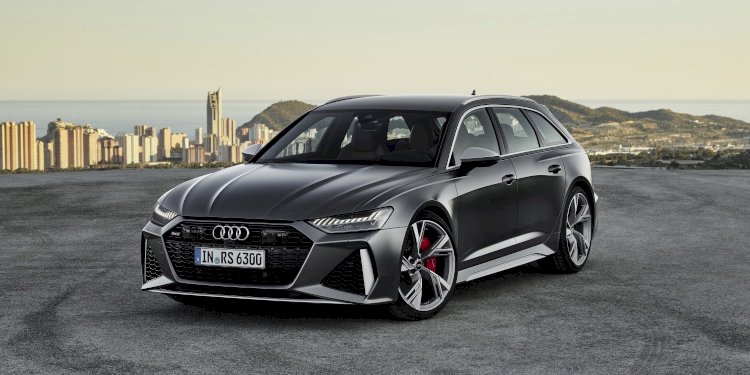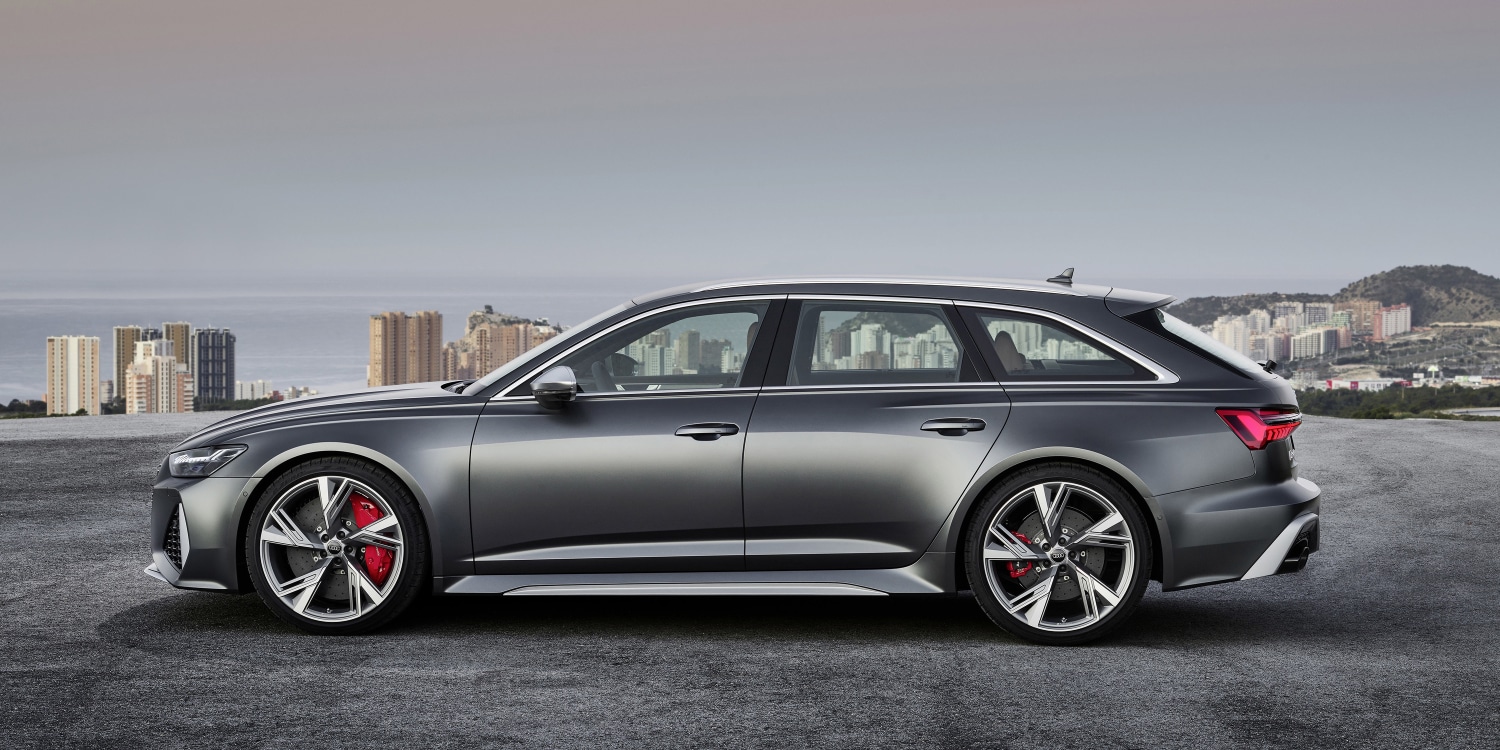Audi RS 6 Avant
25 years of RS, 25 years of high-performance station wagons from Audi: With the new Audi RS 6, they are ushering in a new chapter in history.
 Photo by Audi AG
Photo by Audi AG
Even more, power combined with increased efficiency thanks to the mild-hybrid system turn the RS 6 Avant into the perfect companion for any purpose.
Broad and powerful: the exterior design
The body style, which is unique in its segment, proves alluring the moment you set eyes on the new Audi RS 6 Avant, even when stationary. The RS model sports an emphatically differentiated design compared with the A6 Avant base model. With the exception of the front doors, roof, and tailgate, the exterior is made up solely of RS-specific parts. The body, which has been widened around 40 millimeters (1.6 in) on each side with its broad flared wheel arches, emphasizes the distinctive character of the high-performance Avant. The 22-inch wheels accentuate the striking proportions.
The entire front-end is differentiated to the maximum, providing a distinctive look within the A6 model line. In addition to the new hood together with the power dome, the RS 6 Avant also adopts the front headlights from the A7 model line. These not only come with a flatter, sportier expression but also offer the option of the RS Matrix LED laser headlight with darkened trims as an additional USP of the RS 6 Avant in the A6 family. Similar to the LED rear lights, they feature a dynamic turn signal along with RS-specific sequencing when the vehicle is locked and unlocked.
The three-dimensional honeycomb structure within the Singleframe grille is finished in gloss black. In combination with the much flatter and wider geometry, this reinforces the athletic look of the RS 6 Avant (combined fuel consumption in l/100 km: 11,7 - 11,5 (20.1 - 20.5 US mpg); combined CO2 emissions in g/km: 268 - 263 (431.3 - 423.3 g/mi)). The Singleframe surround and the Quattro logo in the bumper have been eliminated. Below the standard LED headlights, side air inlets open on the strikingly drawn new RS bumper and extend almost into the lower edge of the headlights. The designers have taken their cue from the front-end of the Audi R8 supercar (combined fuel consumption in l/100km: 13.3 - 12.9 (17.7 - 18.2 US mpg); combined CO2 emissions in g/km: 301 - 293 (484.4 - 471.5 g/mi)).
The characteristic Avant silhouette dominates in the side view - elongated front section, long, straight roofline, and flat D pillars, which rest on the Quattro blisters. The RS-specific sills with black inserts visually emphasize on the flanks the pronounced forward thrust. The dynamic rear-end consists of the roof edge spoiler and an RS-specific bumper with rear diffuser and design elements in gloss black. In hallmark RS style, the RS exhaust system flows on both sides into oval chrome-colored tailpipes - an RS sport exhaust system with black tailpipes is available as an option.
 The new Audi RS 6 Avant
The new Audi RS 6 Avant
Supreme power package: the engine
The 4.0 TFSI in the new Audi RS 6 Avant delivers 441 kW (600 metric hp) and 800 Nm (590.0 lb-ft) of torque, which is maintained at this high level between 2,050 and 4,500 rpm. In just 3.6 seconds the high-performance station wagon sprints from zero to 100 km/h (62.1 mph). And in a mere 12 seconds, the RS 6 Avant reaches 200 km/h (124.3 mph). Top speed is electronically governed at 250 km/h (155.3 mph). With the optional dynamic package, the RS station wagon does up to 280 km/h (174.0 mph) or even up to 305 km/h (189.5 mph) with the dynamic package plus.
Thanks to the 48-volt main electrical system the twin-turbo V8 combines maximum performance with high efficiency. A belt alternator starter lies at the heart of the mild-hybrid system (MHEV). Up to 12 kW of power can be recovered during light deceleration and stored in a separate lithium-ion battery. If the driver takes their foot off the accelerator at a speed between 55 and 160 km/h (34.2 to 99.4 mph), the drive management selects one of two options: Depending on the driving situation and setting in the Audi drive select the new RS 6 Avant recovers energy or coasts up to 40 seconds with the engine switched off. Pressing the accelerator makes the belt alternator starter restart the engine. MHEV technology allows for start/stop operation at speeds of up to 22 km/h (13.7 mph). Fuel savings of up to 0.8 liters per 100 kilometers are possible in everyday driving.
The cylinder on demand (COD) system is also onboard as another efficiency component. At low through intermediate load and speed, it deactivates cylinders 2, 3, 5, and 8 in the high gears by switching off injection and ignition and closing the intake and exhaust valves. In four-cylinder operation, the operating points in the active cylinders are displaced toward higher loads in areas of the characteristic map with higher efficiency, while the deactivated cylinders largely run without losses, like gas springs. When the driver presses the accelerator pedal, they are reactivated instantly.
For all its efficiency the 4.0 TFSI develops a sporty, voluminous V8 sound. The driver can influence the engine sound using the Audi drive select system. The optional RS sport exhaust system with black tailpipe trims ensures a maximum sporty sound experience. In the customizable RS1 and RS2 modes, customers decide whether the sound should be sporty or balanced.
The standard eight-speed Tiptronic with optimized shift times transmits the power of the 4.0 TFSI to the Quattro permanent all-wheel drive. The drive forces are distributed to the front and rear axle in a ratio of 40:60 via the all-mechanical center differential. If one wheel slips, more drive torque automatically goes to the axle with better traction. Up to 70 percent can flow to the front wheels and up to 85 percent to the rear wheels.
The wheel-selective torque control optimizes the agile and safe handling of the new RS 6 Avant - it brakes the wheels with reduced load on the inside of a bend slightly before they can begin to spin. The Quattro sport differential in the optional dynamic package and dynamic package plus shifts the drive torque when cornering at speed as required between the rear wheels, thus improving traction, stability, and dynamics.
The new Audi RS 6 Avant will go on sale in dealerships in Germany and other European countries by the end of 2019. The basic price will be EUR 117,500.
Find more Cars
Lamborghini Centenario Roadster
One-off limited edition of 20 roadsters following the introduction of the c...
The new Maserati GranTurismo
Maserati presents the new GranTurismo, marking a new chapter in a story tha...
Bentley goes dark with new Black Edition models
Bentley's new Black Edition models combine the dark, daring, and assertive ...
The Rolls-Royce Wraith Kryptos Collection
Rolls-Royce Collection Cars are poetic embodiments of artistry and skill, e...
The Koenigsegg Regera
Regera is Swedish for To Reign - a suitable name for a machine that offers ...
Partnership for the sound of the future
Hans Zimmer is now the official composer and curator for BMW IconicSounds E...




















